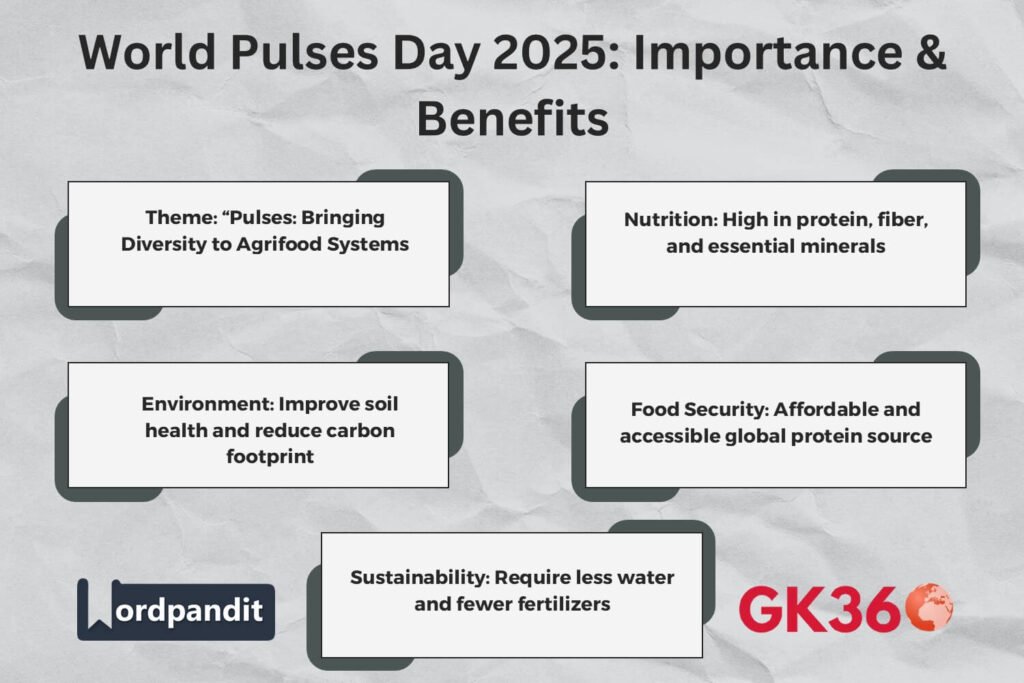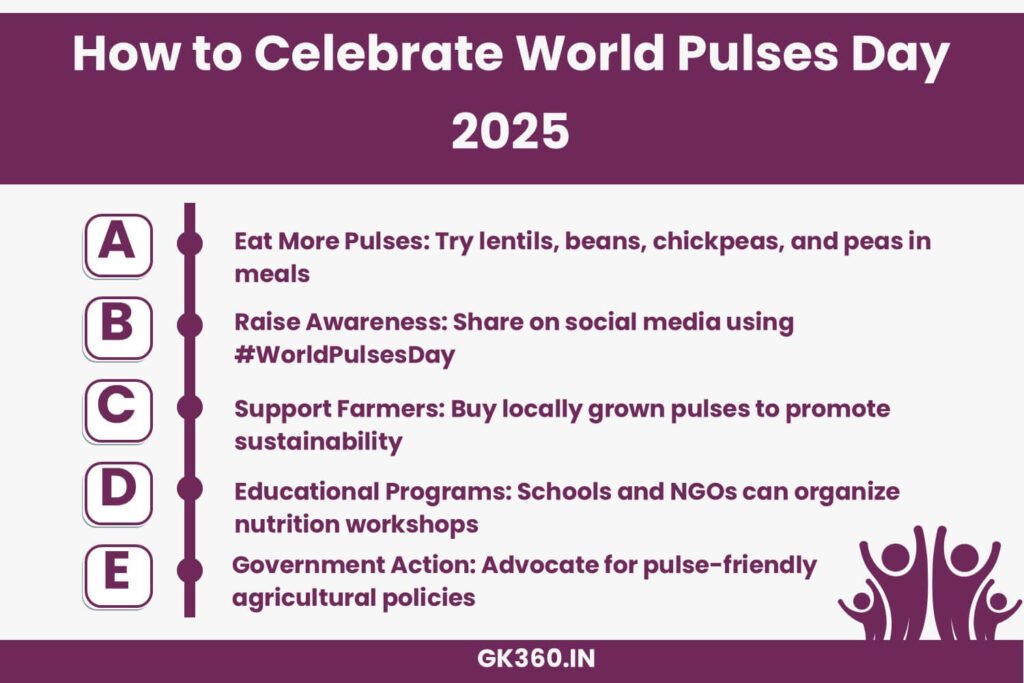World Pulses Day 2025: Theme, History, Benefits & How to Celebrate
Introduction
World Pulses Day is celebrated annually on February 10 to highlight the importance of pulses in ensuring food security, sustainable agriculture, and human nutrition. Recognized by the United Nations (UN) and the Food and Agriculture Organization (FAO), this global observance emphasizes the role of pulses in reducing hunger, promoting health, and protecting the environment.
For World Pulses Day 2025, the FAO has announced the theme:
“Pulses: Bringing Diversity to Agrifood Systems”
This theme underscores how pulses contribute to biodiversity, soil health, and global food systems, making them an essential part of sustainable agriculture.
Table of Contents
- What is World Pulses Day?
- History and UN Recognition
- Theme for World Pulses Day 2025
- Nutritional and Environmental Benefits of Pulses
- Challenges in Promoting Pulses Consumption
- How to Celebrate World Pulses Day 2025
- Key Facts & FAQs
- Conclusion
What is World Pulses Day?
Pulses, often referred to as legumes, are the edible seeds of plants in the Fabaceae family. They include beans, lentils, chickpeas, and peas, which are harvested for their dry grains and are distinct from legumes like soybeans and peanuts.
World Pulses Day was established by the United Nations to promote awareness about the benefits of pulses in nutrition, economic stability, and environmental sustainability. Pulses play a vital role in providing an affordable source of protein while contributing to sustainable farming practices.
History and UN Recognition
The significance of pulses in food security and global health led to their recognition by the United Nations General Assembly (UNGA):
- 2013: The UNGA adopted Resolution A/RES/68/231, declaring 2016 as the International Year of Pulses to raise global awareness.
- 2016: The FAO led an awareness campaign on the nutritional and environmental benefits of pulses.
- 2019: Following the success of the International Year of Pulses, Burkina Faso proposed an annual World Pulses Day to continue promoting their benefits.
- February 10, 2019: The UN officially declared World Pulses Day, celebrated annually to highlight their role in sustainable agriculture and global nutrition.
Theme for World Pulses Day 2025
The official theme for World Pulses Day 2025 is:
“Pulses: Bringing Diversity to Agrifood Systems”
This theme highlights how pulses play a crucial role in improving global food systems by enhancing agricultural biodiversity, strengthening food security, and promoting sustainable farming.
🌱 How Pulses Contribute to Agrifood Systems:
- ✅ Improve biodiversity by enriching soil with nitrogen, reducing the need for synthetic fertilizers.
- ✅ Enhance food security by providing a nutrient-rich, affordable food source.
- ✅ Promote sustainable farming by reducing water usage and greenhouse gas emissions.
By integrating pulses into global agrifood systems, countries can create a more resilient, diverse, and eco-friendly food production model.
Nutritional and Environmental Benefits of Pulses
🥗 1. Nutritional Benefits
Pulses are a powerhouse of essential nutrients, making them a key part of a balanced diet:
- ✔ High in Protein: Essential for vegetarians and vegans.
- ✔ Rich in Fiber: Aids digestion and promotes gut health.
- ✔ Lowers Cholesterol: Reduces LDL (bad cholesterol) and supports heart health.
- ✔ Regulates Blood Sugar: Low glycemic index makes them ideal for diabetics.
- ✔ Packed with Vitamins & Minerals: Iron, potassium, and folate for overall health.
🌍 2. Environmental Benefits
Pulses contribute significantly to a sustainable environment:
- 🌱 Fix Nitrogen in Soil: Reduce reliance on synthetic fertilizers.
- 💧 Water-Efficient Crops: Require significantly less water than other crops.
- 🌎 Lower Carbon Footprint: Reduce greenhouse gas emissions compared to meat production.
- 🌿 Enhance Soil Health: Improve crop rotation and biodiversity.
Challenges in Promoting Pulses Consumption
Despite their numerous benefits, several barriers limit the widespread consumption of pulses:
🚧 1. Lack of Awareness
- 📢 Many people are unaware of the nutritional and environmental benefits of pulses.
💰 2. Market Accessibility
- 🌍 Some regions face limited availability and higher prices for certain pulses.
🥘 3. Dietary Preferences
- 🍽️ Cultural and habitual food choices influence lower consumption in some countries.
📢 4. Policy & Support
- 🏛️ Stronger governmental and institutional policies are needed to promote pulses.
✅ Solutions:
- 🌾 Subsidizing pulse farming to improve accessibility.
- 🥗 Developing innovative pulse-based products in the food industry.
- 🎓 Educating communities on the benefits of pulses through public health campaigns.
How to Celebrate World Pulses Day 2025
Individuals, organizations, and governments can take part in World Pulses Day 2025 through various activities:
🥗 1. Incorporate Pulses into Meals
- ✅ Cook dishes like Indian dal, Middle Eastern hummus, or Mexican refried beans.
📣 2. Raise Awareness
- ✅ Share pulse-related facts on social media using hashtags like #WorldPulsesDay.
🌍 3. Support Local Farmers
- ✅ Purchase locally grown pulses to boost sustainable farming.
🎓 4. Educational Campaigns
- ✅ Schools and universities can organize workshops on nutrition and sustainability.
💡 5. Government & NGO Initiatives
- ✅ Support policies promoting pulse farming and food security programs.
By making small dietary and policy changes, we can increase pulse consumption globally, leading to better health and environmental sustainability.
Key Facts & FAQs
📌 Key Facts About World Pulses Day 2025
- 📅 Date: February 10, 2025
- 🌱 Organized by: FAO & UN
- 📢 Theme: “Pulses: Bringing Diversity to Agrifood Systems”
- 🥗 Health Benefits: High in protein, fiber, vitamins & minerals
- 🌎 Environmental Benefits: Improve soil health, reduce carbon footprint, and require less water
❓ Why do we celebrate World Pulses Day?
✅ To raise awareness about the nutritional, economic, and environmental benefits of pulses.
❓ How do pulses help in sustainability?
✅ Pulses fix nitrogen in the soil, reducing the need for synthetic fertilizers, lower water consumption, and decrease carbon emissions.
❓ How can I include more pulses in my diet?
✅ Add lentils, beans, and chickpeas to soups, salads, curries, and spreads like hummus.
❓ What role do pulses play in food security?
✅ Pulses provide an affordable, high-protein food source that supports global efforts in reducing hunger and malnutrition.
❓ What is the impact of pulses on climate change?
✅ Compared to livestock farming, pulses generate significantly lower greenhouse gas emissions, making them a more sustainable protein source.
Conclusion
World Pulses Day 2025 serves as a powerful reminder of the importance of pulses in global nutrition, environmental sustainability, and food security. With the theme “Pulses: Bringing Diversity to Agrifood Systems”, this year’s observance highlights the essential role pulses play in enhancing biodiversity and strengthening agrifood systems.
As February 10, 2025, approaches, let’s celebrate World Pulses Day by integrating pulses into our diets, supporting sustainable agriculture, and spreading awareness about their countless benefits. 🌱💚
Key Takeaways
| Aspect | Details |
|---|---|
| Date | February 10, 2025 |
| Theme | “Pulses: Bringing Diversity to Agrifood Systems” |
| Nutritional Benefits | High in protein, fiber, iron, and vitamins |
| Environmental Benefits | Improve soil health, require less water, and reduce carbon footprint |
| Challenges | Lack of awareness, market accessibility, dietary preferences |
| Ways to Celebrate | Cook pulses, share awareness, support farmers, advocate policies |
| Impact on Food Security | Affordable protein source reducing hunger and malnutrition |
Related Terms:
- World Pulses Day 2025
- Pulses for Sustainable Farming
- Health Benefits of Pulses
- Pulses and Food Security
- UN & FAO Pulses Initiative
- How to Celebrate World Pulses Day
- Nitrogen-Fixing Crops for Sustainability
- Plant-Based Protein Alternatives
- Reducing Carbon Footprint with Pulses
- Pulses in Global Nutrition







